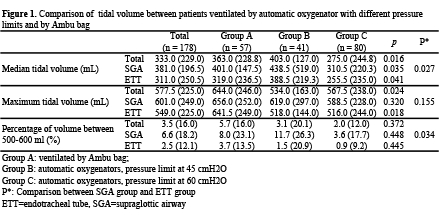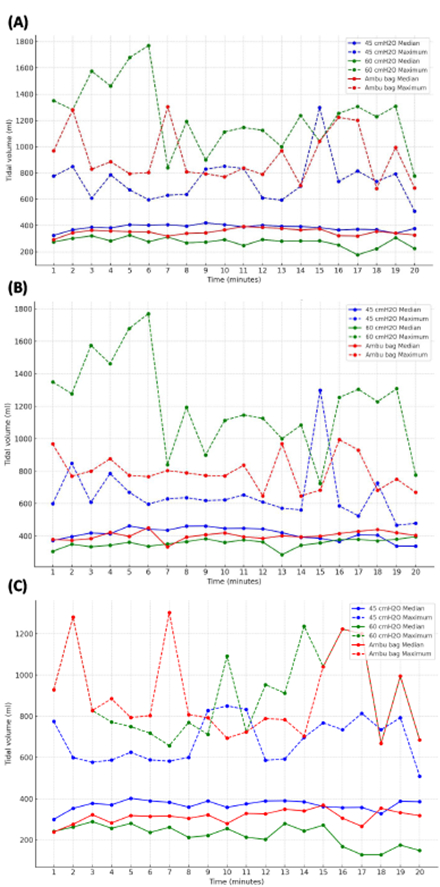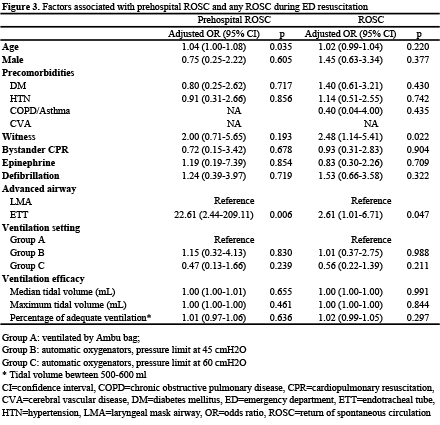Final ID: Sa104
Ventilation Efficacy of Automatic Oxygenators for Patients with Out-of-Hospital Cardiac Arrests at Different Pressure Limits in Prehospital Settings
Abstract Body: Background: Automatic oxygenators can be used for ventilation in out-of-hospital cardiac arrest (OHCA) patients. However, their efficacy under different pressure limits is unknown.
Research Question: Does the ventilation efficacy of Ambu bag and automatic oxygenators under different pressure limits differ in OHCA patients during prehospital resuscitation?
Aims: To compare the ventilation efficacy of Ambu bag and automatic oxygenators under different pressure limits and investigate the association of different ventilation settings with patient outcomes.
Methods: This retrospective study included adult patients with non-traumatic OHCA who received prehospital advanced airway in Hsinchu county, Taiwan, in 2023. Patients were categorized into three groups: Group A (ventilated by Ambu bag), Group B (automatic oxygenators, pressure limit at 45 cmH2O), and Group C (automatic oxygenators, pressure limit at 60 cmH2O). Ventilation efficacy was monitored by recording tidal volume using Zoll® X-series monitors. The median and maximum tidal volume and percentage of adequate ventilation (tidal volume between 500-600 ml) of each patient among 3 groups were compared. Associations between ventilation settings, efficacy, and patient outcomes were analyzed using multivariable logistic regression.
Results: Group A, Group B, and Group C consisted of 57 (32.0%), 41 (23.0%), and 80 (45.5%) OHCA patients, respectively. The demographics and prehospital managements, including advanced airway type (laryngeal mask [LMA] or endotracheal tube [ETT]), did not differ between groups. The median tidal volume was highest in Group B, followed by Group A and C (Group A: 363.0 ml, Group B: 403.0 ml, Group C: 275.0 ml, p = 0.016). The median maximum tidal volume was highest in Group A, followed by Group C and B (Group A: 644.0 ml, Group B: 534.0 ml, Group C: 567.5 ml, p = 0.024). The median percentages of adequate ventilation were equally low in 3 groups, (Group A: 5.7%, Group B: 3.1%, Group C: 2.0%, p = 0.372). Different ventilation settings or efficacy were not associated with prehospital or in-hospital return of spontaneous circulation. However, patients receiving prehospital ETT insertion had better outcomes than those with LMA.
Conclusion: This study presents the ventilation efficacy of OHCA patients ventilated by Ambu bag or automatic oxygenators under different pressure limits. Despite slight differences in tidal volumes measured across groups, patient outcomes did not differ significantly.
Research Question: Does the ventilation efficacy of Ambu bag and automatic oxygenators under different pressure limits differ in OHCA patients during prehospital resuscitation?
Aims: To compare the ventilation efficacy of Ambu bag and automatic oxygenators under different pressure limits and investigate the association of different ventilation settings with patient outcomes.
Methods: This retrospective study included adult patients with non-traumatic OHCA who received prehospital advanced airway in Hsinchu county, Taiwan, in 2023. Patients were categorized into three groups: Group A (ventilated by Ambu bag), Group B (automatic oxygenators, pressure limit at 45 cmH2O), and Group C (automatic oxygenators, pressure limit at 60 cmH2O). Ventilation efficacy was monitored by recording tidal volume using Zoll® X-series monitors. The median and maximum tidal volume and percentage of adequate ventilation (tidal volume between 500-600 ml) of each patient among 3 groups were compared. Associations between ventilation settings, efficacy, and patient outcomes were analyzed using multivariable logistic regression.
Results: Group A, Group B, and Group C consisted of 57 (32.0%), 41 (23.0%), and 80 (45.5%) OHCA patients, respectively. The demographics and prehospital managements, including advanced airway type (laryngeal mask [LMA] or endotracheal tube [ETT]), did not differ between groups. The median tidal volume was highest in Group B, followed by Group A and C (Group A: 363.0 ml, Group B: 403.0 ml, Group C: 275.0 ml, p = 0.016). The median maximum tidal volume was highest in Group A, followed by Group C and B (Group A: 644.0 ml, Group B: 534.0 ml, Group C: 567.5 ml, p = 0.024). The median percentages of adequate ventilation were equally low in 3 groups, (Group A: 5.7%, Group B: 3.1%, Group C: 2.0%, p = 0.372). Different ventilation settings or efficacy were not associated with prehospital or in-hospital return of spontaneous circulation. However, patients receiving prehospital ETT insertion had better outcomes than those with LMA.
Conclusion: This study presents the ventilation efficacy of OHCA patients ventilated by Ambu bag or automatic oxygenators under different pressure limits. Despite slight differences in tidal volumes measured across groups, patient outcomes did not differ significantly.
More abstracts on this topic:
Assessment Of Medical Students' Knowledge Before And After Basic Life Support Training At A University In Southeast Pará
Bueno Claudia, Souza Barbara, Santos Aline, Da Silva Ferreira Laíse Jorrana, Varao Thawanny, Cunha Carneiro Maria Angelica, Gomes Laysa, Teixeira Costa Ana Carolina, Miranda Luana, Martin Joelma, Rocha Nathalia, Dias Adria
An Evaluation of Bystander CPR by Race, Accounting for Social Drivers of HealthLane Nina, Crowe Remle, Salcido David



